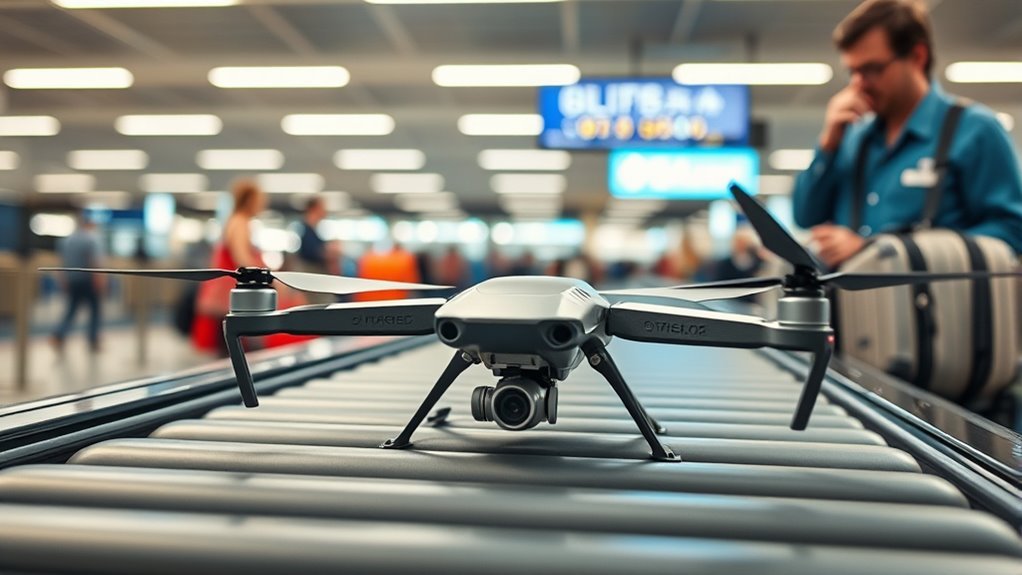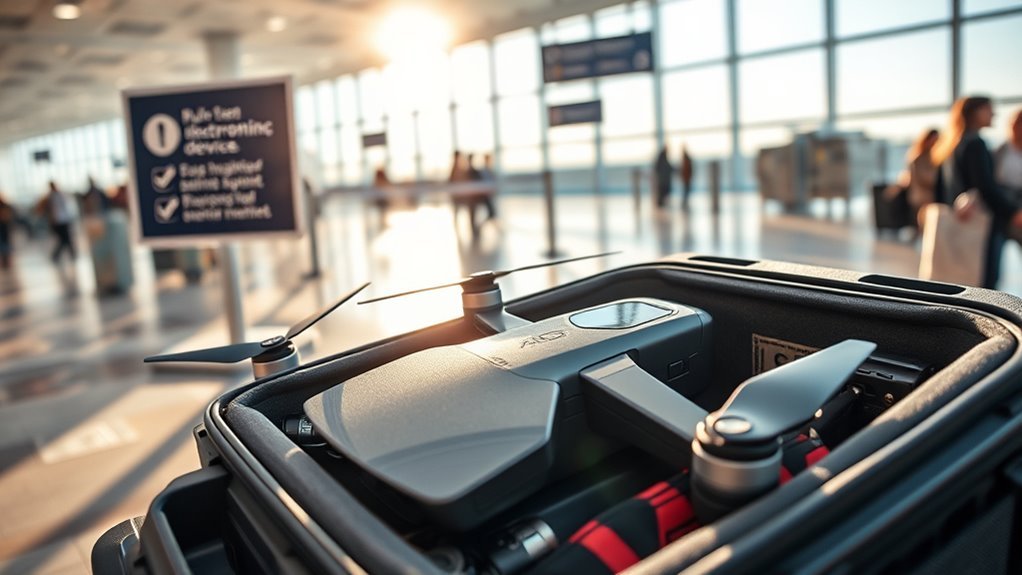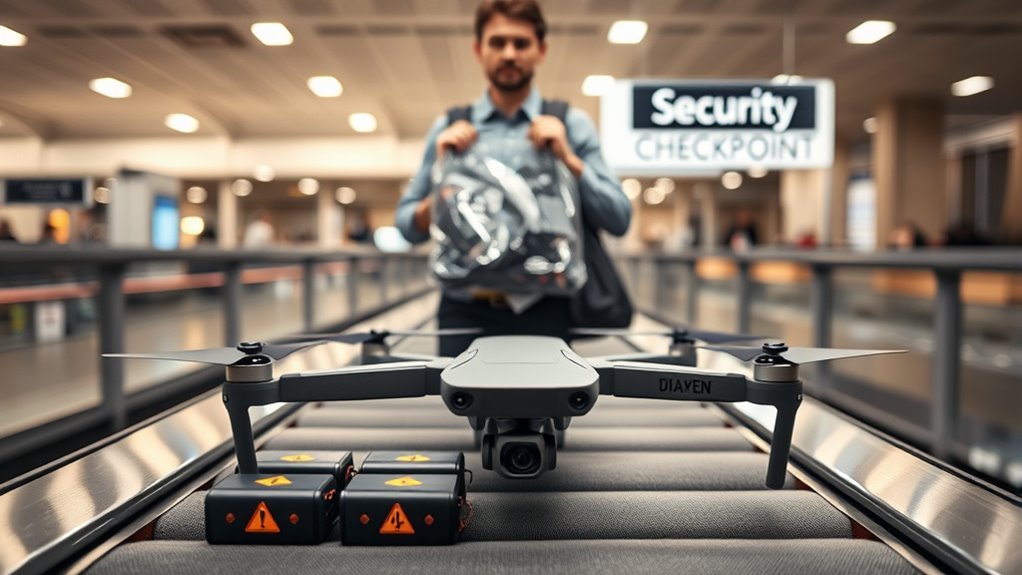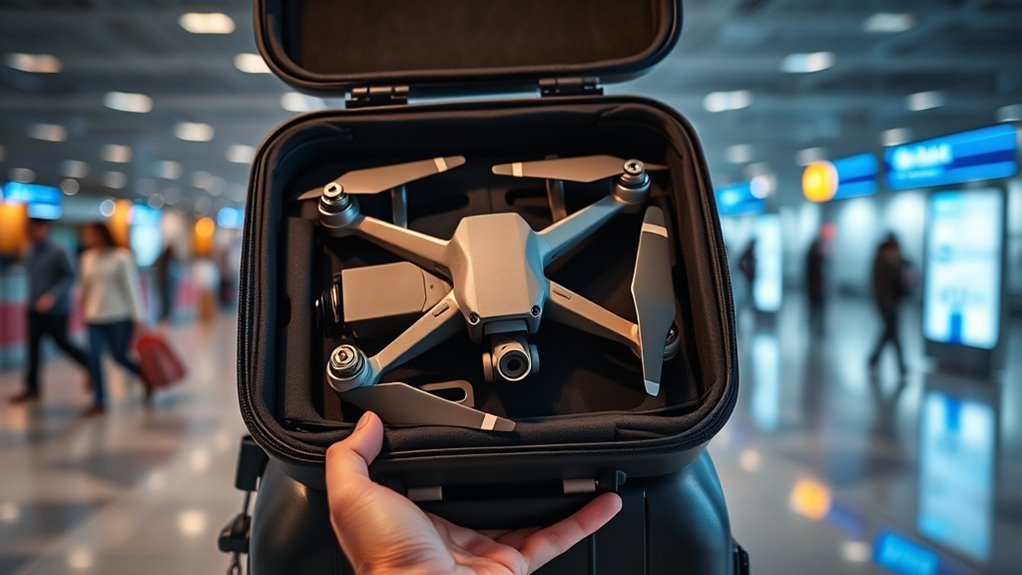To bring a drone on an airplane, familiarize yourself with airline policies and battery regulations. Keep your drone and batteries in carry-on luggage, ensuring terminals are protected from short circuits. Prepare your drone by cleaning it, using a dedicated travel case, and removing accessories. During security, cooperate with personnel for smooth screening. Before you travel, research local drone laws and registration requirements. Stick around for more tips on a hassle-free journey with your drone.
Understanding Airline Policies for Drones

Before you pack your drone for air travel, it’s crucial to understand the specific policies of the airline you’ll be flying with, as these can vary greatly. Different airlines impose unique airline restrictions based on drone sizes, so knowing your equipment is key. For example, many carriers allow drones under a certain weight to be carried in your carry-on luggage, while larger models may require special handling or even be prohibited entirely. Additionally, some airlines restrict batteries, particularly lithium-ion ones, which are often a critical part of your drone setup. Familiarize yourself with both size and battery regulations to avoid surprises at the airport. Being informed guarantees you can travel freely with your drone while adhering to necessary guidelines.
Preparing Your Drone for Travel

As you prepare your drone for travel, guaranteeing it’s properly packed and secured is essential to avoid damage during transit. Start by performing thorough drone maintenance; check for loose parts and give your drone a good cleaning. Use a dedicated travel case designed for your model—this’ll provide maximum protection. When packing, remove the propellers and any accessories, placing them in separate compartments to prevent breakage. Don’t forget to include travel accessories like lens covers and padded dividers. These will safeguard your drone against impacts. Additionally, consider checking your drone’s flight performance and endurance to ensure optimal functionality and battery life during your trip. Finally, consider wrapping your drone in a soft cloth for added cushioning. Taking these precautions guarantees your drone arrives ready for adventure, giving you the freedom to capture stunning aerial footage wherever you go. Additionally, ensuring your drone’s advanced camera capabilities are well-protected will help maintain its performance and quality during your travels.
Battery Regulations and Safety

Packing your drone safely is only part of the equation; understanding battery regulations is equally important for a hassle-free travel experience. Different battery types come with specific restrictions, particularly lithium polymer (LiPo) batteries, which are common in drones. Airlines often enforce strict charging limits to minimize fire hazards.
| Battery Type | Charging Limit |
|---|---|
| LiPo | 100Wh |
| Li-ion | 160Wh |
| NiMH | 300Wh |
Always carry batteries in your carry-on luggage, never in checked baggage. Confirm terminals are taped or placed in protective cases to prevent short circuits. By adhering to these regulations, you’ll enjoy your drone adventures without unexpected delays.
Packing Your Drone Properly
To guarantee your drone arrives intact at your destination, take care to pack it properly. Start by investing in a high-quality protective case designed specifically for your model. These cases not only safeguard your drone but also keep your drone accessories organized. Remove the propellers and any detachable components to minimize space and prevent damage. Use foam inserts or bubble wrap to cushion your drone and its accessories, making sure they don’t shift during transit. Avoid packing it in checked luggage; instead, carry it on to maintain control over its safety. Finally, confirm the case is clearly labeled and compliant with airline regulations to avoid unnecessary delays. By following these guidelines, you’ll enjoy the freedom to fly upon arrival.
Navigating Security Checks
When you approach security checks at the airport, you’ll need to be prepared for specific screening procedures related to your drone. Make certain that your drone is packed according to airline regulations and that you understand battery restrictions, as lithium-ion batteries often have particular guidelines. Being informed about these details will streamline your experience and help you avoid potential delays.
Security Screening Procedures
Although maneuvering security checks can be intimidating, understanding the procedures for bringing a drone on an airplane will make the process smoother. You’ll need to verify your drone passes security clearance, so be prepared for thorough screening. The TSA uses various screening equipment to examine your drone and its components. Here’s a quick reference table to help you navigate the screening process:
| Item | Security Clearance Required | Notes |
|---|---|---|
| Drone Body | Yes | Place in bin for scanning |
| Batteries | Yes | Must be in carry-on |
| Remote Controller | Yes | Can stay in your bag |
| Accessories (props, etc.) | Yes | Separate for clearer screening |
Stay calm and cooperate with security personnel to verify a hassle-free experience.
Packing Guidelines
Packing your drone for air travel requires careful attention to confirm compliance with airline and TSA regulations. Start by measuring your drone dimensions to verify it fits within the airline’s carry-on guidelines. A well-fitted protective case is essential, not only for safeguarding your equipment but also for passing through security checks smoothly.
- Use a soft or hard protective case that accommodates your drone’s size.
- Remove any detachable parts, like propellers, to reduce bulk.
- Include necessary accessories, like a remote controller, in the same case.
- Keep the drone accessible for quick inspection during security screening.
Battery Regulations
Steering through battery regulations is essential for a hassle-free travel experience with your drone. First, know the battery types you’re carrying; lithium-ion batteries are the most common and generally subject to strict limits. Most airlines allow lithium batteries under 100 watt-hours without special permission, but larger batteries may require approval. Always store your batteries in protective cases to prevent short-circuiting, as this can lead to dangerous situations. Keep your batteries in your carry-on luggage, as they’re typically prohibited in checked bags. Remember to check airline-specific regulations, as they can vary. By understanding these guidelines, you’ll guarantee your drone and its batteries travel smoothly, allowing you the freedom to fly wherever your adventures take you.
International Travel Considerations
When planning to take a drone on an international flight, it’s vital to research the regulations of both your departure and destination countries. Understanding customs regulations is important to avoid complications. Here are some key considerations:
- Check if your drone requires registration or permits in your destination country.
- Review local laws regarding drone use, including no-fly zones. Ensure you adhere to India’s regulatory framework to avoid penalties while operating your drone.
- Confirm you have drone insurance that covers international travel.
- Be aware of potential customs fees or restrictions on bringing drones into foreign countries. Additionally, ensure you are familiar with drone regulations to avoid legal issues during your travels.
Taking the time to familiarize yourself with these factors helps you travel freely and enjoy your drone experience without the hassle of unexpected legal issues or fines.
Registering Your Drone
Before you can take your drone on an airplane, you need to understand the registration requirements. It’s essential to follow the correct steps for registering your drone to guarantee compliance with aviation regulations. This process not only protects you legally but also assures a smooth travel experience.
Registration Requirements Overview
Although registering your drone may seem like a challenging task, it’s an essential step to guarantee compliance with regulations and avoid potential fines. Understanding the drone registration requirements is vital for every pilot who values their freedom to fly. Here’s what you need to know:
- FAA Guidelines: The Federal Aviation Administration mandates registration for drones over 0.55 pounds.
- Registration Fees: There’s a nominal fee, typically around $5, which covers your registration for three years.
- Identification: You’ll receive a registration number that must be displayed on your drone.
- Age Requirement: You must be at least 13 years old to register your drone online.
Registration Process Steps
Registering your drone is a straightforward process that guarantees you’re compliant with FAA regulations. To begin the registration process, visit the FAA’s DroneZone website. You’ll need to create an account if you don’t have one. Once logged in, provide your drone identification details, including the make, model, and serial number. After that, pay the registration fee, which is typically $5. You’ll then receive a unique FAA registration number. Make sure to label your drone with this number—it’s essential for identification. Finally, keep a copy of your registration certificate handy when traveling. Following these steps not only helps you avoid fines but also guarantees you can enjoy your flying experiences with peace of mind.
Local Drone Laws and Regulations
Understanding local drone laws and regulations is essential, especially since they can vary greatly from one jurisdiction to another. Ignoring these laws can lead to serious legal consequences that may affect your freedom to operate your drone. Before you fly, it’s imperative to familiarize yourself with the rules specific to your location.
Familiarizing yourself with local drone laws is crucial to avoid legal issues and ensure safe operations.
- Research no-fly zones and restricted airspace.
- Check for registration requirements specific to your area.
- Be aware of altitude limits and operational times, including local temporary flight restrictions during events.
- Understand privacy laws regarding drone usage. Additionally, ensure compliance with registration and licensing requirements to avoid penalties.
Tips for In-Flight Use of Drones
When you’re onboard an airplane, using a drone can be tricky due to strict regulations and safety protocols. First and foremost, always respect in-flight etiquette; this means keeping your drone stored away during takeoff and landing. Once cruising altitude is reached, check with the cabin crew before considering any use. Most airlines prohibit drone operation due to safety concerns. If you’re capturing drone photography, consider doing so only at your destination. Prioritize safety and guarantee your drone is fully charged and ready for outdoor use once you land. Remember, the freedom to enjoy your drone comes with the responsibility to follow airline rules and respect fellow passengers. Always be mindful of your surroundings and the implications of your actions.
Resources for Drone Travelers
Before you travel with your drone, it’s essential to familiarize yourself with each airline’s specific policies regarding drone transport. Additionally, checking local regulations at your destination will guarantee you’re compliant and avoid potential fines or confiscation. By staying informed, you can enjoy your trip without the stress of unexpected surprises.
Airline Policies Overview
As you plan your trip, it’s vital to familiarize yourself with the varying airline policies regarding drone transport. Airlines have specific guidelines that can affect your travel, so it’s important to be informed. Here’s what you should consider:
- Drone Insurance: Check if your policy covers travel-related incidents.
- Battery Regulations: Know the limits on lithium batteries to avoid confiscation.
- Size and Weight Limits: Each airline has different maximum dimensions and weights for carry-ons.
- Travel Restrictions: Be aware of any destination-specific drone regulations that could impact your ability to fly.
Understanding these elements can guarantee a smoother travel experience, helping you enjoy your drone adventures without unexpected hurdles.
Local Regulations Check
Maneuvering local regulations is essential for any drone traveler. Before you take off, familiarize yourself with the local drone laws and state regulations of your destination. Each area has its unique set of rules governing drone operations, from where you can fly to required permits. Some cities may impose strict no-fly zones, especially near airports, parks, or populated areas. Ignoring these laws can result in hefty fines or confiscation of your equipment, so it’s important to do your homework. Check online resources, local government websites, or drone community forums for the most accurate and updated information. By ensuring compliance with local regulations, you’ll enjoy your drone experience while respecting the rights and safety of others.
Frequently Asked Questions
Can I Use My Drone During Layovers at Airports?
You can’t use your drone during layovers without checking layover regulations and airport policies. Many airports prohibit flying drones on-site, so always verify local rules to avoid any complications or fines during your travels.
Are There Size Restrictions for Drone Cases on Airplanes?
Yes, there’re size restrictions for drone cases on airplanes. Check the airline’s guidelines for drone dimensions and make certain your case material is sturdy yet lightweight. Meeting these requirements guarantees a hassle-free travel experience with your drone.
Can I Carry Multiple Drones in One Trip?
Packing multiple drones for a trip’s like juggling eggs; it requires careful balance. Check airline policies on drone limits, and follow drone packing tips to guarantee you can transport them safely without hassle.
What Should I Do if My Drone Gets Damaged in Transit?
If your drone gets damaged in transit, assess the damage immediately. Contact your insurance provider about claims, and explore repair options with authorized services to restore your drone’s functionality. Don’t hesitate to seek professional advice.
Can I Fly My Drone Upon Arrival at My Destination?
When you arrive at your destination, like a bird seeking the open sky, remember to check local drone regulations. Each area has its own flying restrictions, so make certain your freedom doesn’t come with unexpected consequences.

